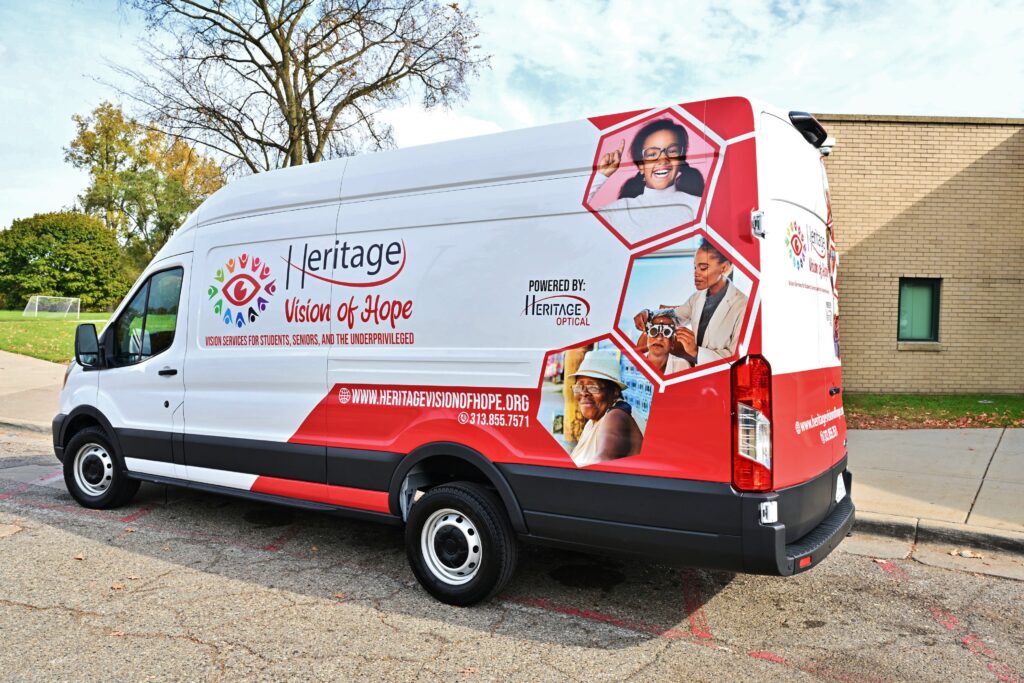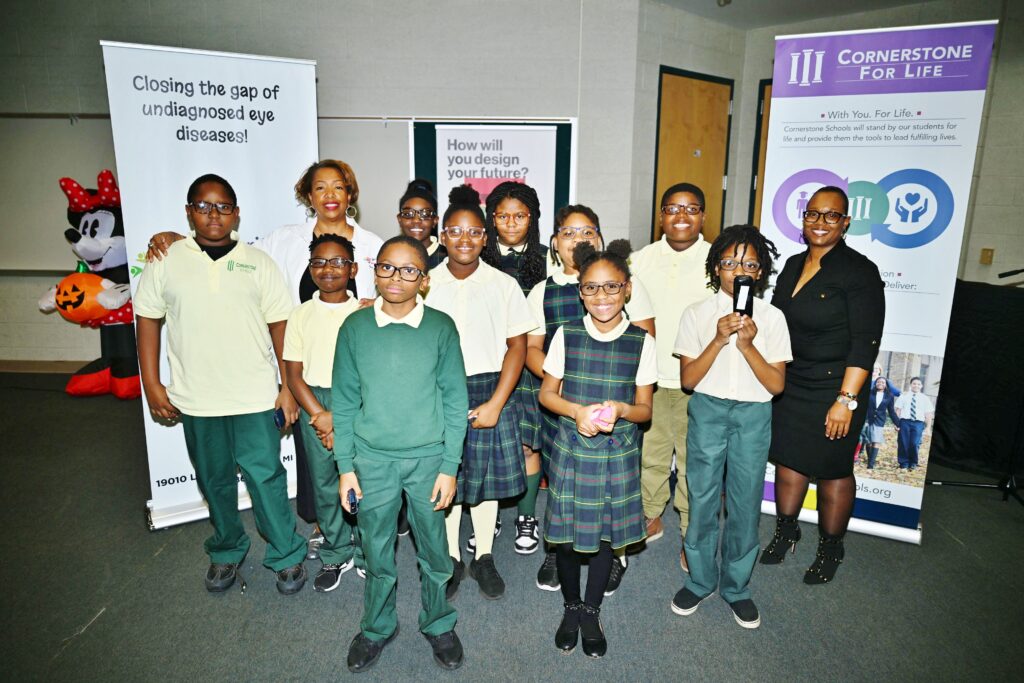Eye exams are essential health care. Heritage Vision of Hope is creating access.
It won’t surprise you to learn that we think vision care is important. Vision is so fundamental to our daily lives, and eye health so closely linked to our overall well-being, that an untreated vision problem can derail us in significant ways.
That’s what makes regular eye exams so critical. They’re relatively quick and non-invasive, and they help identify a wide range of health problems, from nearsightedness to multiple sclerosis. And when people get the exams and glasses they need, they face fewer difficulties in everyday life. They can see blackboards in school, participate in sports, and even have an easier time getting out to socialize. Quality vision care is life changing.
And yet, too many people in southeast Michigan go without regular vision care. Members of underserved communities face cost and access hurdles that make eye exams challenging: trouble getting time off; lack of insurance; no care providers nearby, or no easy way to get to one.
So in 2024, with help from Michigan’s Racial Disparities Task Force Grant, we brought care to them with Heritage Vision of Hope.
Addressing the unique needs of underserved and vulnerable groups
When experiencing untreated vision issues, children and seniors face unique consequences. For children, who frequently have to take in important information from far away (the blackboard) or up close (a book or test), refractive errors like nearsightedness or farsightedness can make school frustrating and painful. Blurry vision can cause headaches and eye strain, and children who can’t keep up with class material will start to struggle academically. Sometimes, these challenges can extend to the social sphere, leading children to withdraw or act out.
Roughly one in four children need glasses to see clearly at school, but across Michigan, more than 200,000 students who need them don’t have them.
Seniors struggle in different, but no less important, ways. Lacking the vision care they need may make it harder for seniors to drive or otherwise maintain their independence. Vision impairments can cause falls or injuries, leading to other health complications. And crucially, many age-related eye conditions are manageable if they’re caught early—but if left untreated for too long, they can cause permanent vision loss.
Delivering vision care where it can make the biggest difference
Low-income communities are hit hardest by lack of access to vision care. If families lack paid time off, a reliable mode of transportation, childcare, insurance, or any number of other resources that can ease logistical hurdles, eye exams may feel like they’re out of reach.

We built Heritage Vision of Hope to bridge the gap. Our mobile care model is designed to travel into communities where access is limited, so we can deliver essential services to our Wayne County neighbors at no cost to them. Here are some of our impact numbers from 2024.
We visited:
- Four charter schools
- Five community organizations for seniors
We delivered:
- More than 800 free comprehensive eye exams
- More than 600 free pairs of prescription glasses
- Referrals for ongoing treatment
Roughly 300 of those pairs of glasses were given to students in grades 2 through 8. According to Monica Thompson, principal of Cornerstone Jefferson-Douglass Academy, it sounds like many of them had a great time at their fittings:
“The Heritage Vision of Hope organization has made an incredible impact on our community at Jefferson Douglass Academy by providing free eye examinations and stylish glasses to our students, all conducted onsite at the school. This initiative not only ensured that our students received essential vision care but also allowed them to choose from a variety of fashionable frames that they were thrilled to wear. The excitement in the air was palpable as students eagerly tried on their new eyewear, boosting their confidence and enthusiasm for learning.”

Our time serving our neighbors showed us that the benefits of eye exams and glasses go beyond sharper vision. With a clearer view of the world, our clients could approach activities with greater confidence and independence. Their future healthcare costs are lower, thanks to early detection, preventive care, and a reduced risk of injury. Over the long term, these effects add up, helping to close the gaps and improve wellness outcomes for underserved communities.
What comes next?
We’re humbled by how well-received Heritage Vision of Hope has been. At the same time, the popularity makes it clear that there’s plenty more work to be done. We’ve identified a handful of opportunities to grow the program, and plan to target them in the coming year:
Expanding our operations: Multiple community organizations heard about our work and reached out to us to coordinate services. We’d like to be able to accept their invitations! In addition, our goal is to offer more locations and times, to accommodate even more potential clients.
Educational opportunities: We know how important vision care is, but we want to spread the word. We see the possibility for educational sessions at schools and community centers, as well as providing exams and glasses.
Additional funding: Cultivating new partnerships and funding sources will help us serve more of our neighbors and spread the program over a wider area.
Follow-up care: Even one eye exam can be life-changing, if it connects someone with a needed pair of glasses, or detects a health issue in early stages. But we can make even more of a difference with sustained care, ensuring that the benefits are ongoing.
High quality vision care is a simple intervention with an outsize impact. Heritage Vision of Hope is a way for us to deepen our connection with our community, and an impactful step in dismantling the obstacles that underserved populations face. Heritage Vision Plans was born in Detroit, and our Michigan roots shape who we are. We’re proud and grateful to be able to give back to the community that made us.
To learn more about Heritage Vision of Hope and get involved, visit the website today.
